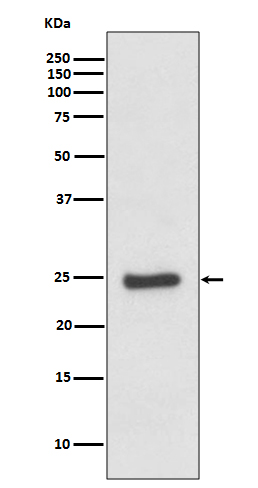Anti-ZNRF2 Rabbit Monoclonal Antibody
- SPECIFICATION
- CITATIONS
- PROTOCOLS
- BACKGROUND

Application
| WB, IHC |
|---|---|
| Primary Accession | Q8NHG8 |
| Host | Rabbit |
| Isotype | Rabbit IgG |
| Reactivity | Rat, Human, Mouse |
| Clonality | Monoclonal |
| Format | Liquid |
| Description | Anti-ZNRF2 Rabbit Monoclonal Antibody . Tested in WB, IHC applications. This antibody reacts with Human, Mouse, Rat. |
| Gene ID | 223082 |
|---|---|
| Other Names | E3 ubiquitin-protein ligase ZNRF2, 2.3.2.27, Protein Ells2, RING finger protein 202, RING-type E3 ubiquitin transferase ZNRF2, Zinc/RING finger protein 2, ZNRF2, RNF202 |
| Calculated MW | 24115 MW KDa |
| Application Details | WB 1:500-1:2000 IHC 1:50-1:100 |
| Subcellular Localization | Endosome membrane ; Peripheral membrane protein. Lysosome membrane ; Peripheral membrane protein. Cell junction, synapse, presynaptic cell membrane ; Peripheral membrane protein. Present in presynaptic plasma membranes in neurons. |
| Tissue Specificity | Highly expressed in the brain, with higher expression during development than in adult. Expressed also in mammary glands, testis, colon and kidney.. |
| Contents | Rabbit IgG in phosphate buffered saline, pH 7.4, 150mM NaCl, 0.02% sodium azide and 50% glycerol, 0.4-0.5mg/ml BSA. |
| Clone Names | Clone: IGB-26 |
| Immunogen | A synthesized peptide derived from human ZNRF2 |
| Purification | Affinity-chromatography |
| Storage | Store at -20°C for one year. For short term storage and frequent use, store at 4°C for up to one month. Avoid repeated freeze-thaw cycles. |
| Name | ZNRF2 |
|---|---|
| Synonyms | RNF202 |
| Function | E3 ubiquitin-protein ligase that plays a role in the establishment and maintenance of neuronal transmission and plasticity. Ubiquitinates the Na(+)/K(+) ATPase alpha-1 subunit/ATP1A1 and thereby influences its endocytosis and/or degradation (PubMed:22797923). Acts also as a positive regulator of mTORC1 activation by amino acids, which functions upstream of the V-ATPase and of Rag-GTPases (PubMed:27244671). In turn, phosphorylation by mTOR leads to its inhibition via targeting to the cytosol allowing a self-regulating feedback mechanism (PubMed:27244671). |
| Cellular Location | Endosome membrane; Peripheral membrane protein. Lysosome membrane; Peripheral membrane protein. Presynaptic cell membrane; Peripheral membrane protein. Cytoplasm |
| Tissue Location | Highly expressed in the brain, with higher expression during development than in adult. Expressed also in mammary glands, testis, colon and kidney. |

Thousands of laboratories across the world have published research that depended on the performance of antibodies from Abcepta to advance their research. Check out links to articles that cite our products in major peer-reviewed journals, organized by research category.
info@abcepta.com, and receive a free "I Love Antibodies" mug.
Provided below are standard protocols that you may find useful for product applications.
If you have used an Abcepta product and would like to share how it has performed, please click on the "Submit Review" button and provide the requested information. Our staff will examine and post your review and contact you if needed.
If you have any additional inquiries please email technical services at tech@abcepta.com.













 Foundational characteristics of cancer include proliferation, angiogenesis, migration, evasion of apoptosis, and cellular immortality. Find key markers for these cellular processes and antibodies to detect them.
Foundational characteristics of cancer include proliferation, angiogenesis, migration, evasion of apoptosis, and cellular immortality. Find key markers for these cellular processes and antibodies to detect them. The SUMOplot™ Analysis Program predicts and scores sumoylation sites in your protein. SUMOylation is a post-translational modification involved in various cellular processes, such as nuclear-cytosolic transport, transcriptional regulation, apoptosis, protein stability, response to stress, and progression through the cell cycle.
The SUMOplot™ Analysis Program predicts and scores sumoylation sites in your protein. SUMOylation is a post-translational modification involved in various cellular processes, such as nuclear-cytosolic transport, transcriptional regulation, apoptosis, protein stability, response to stress, and progression through the cell cycle. The Autophagy Receptor Motif Plotter predicts and scores autophagy receptor binding sites in your protein. Identifying proteins connected to this pathway is critical to understanding the role of autophagy in physiological as well as pathological processes such as development, differentiation, neurodegenerative diseases, stress, infection, and cancer.
The Autophagy Receptor Motif Plotter predicts and scores autophagy receptor binding sites in your protein. Identifying proteins connected to this pathway is critical to understanding the role of autophagy in physiological as well as pathological processes such as development, differentiation, neurodegenerative diseases, stress, infection, and cancer.



